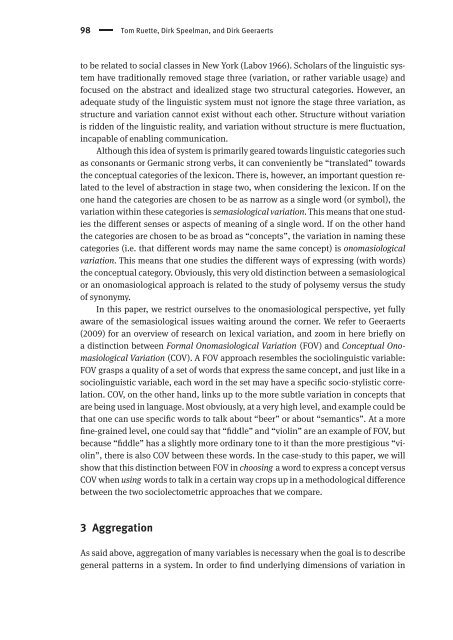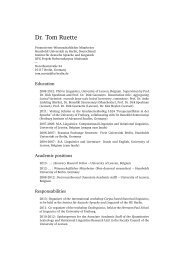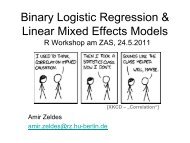Lexical variation in aggregate perspective
Lexical variation in aggregate perspective
Lexical variation in aggregate perspective
Create successful ePaper yourself
Turn your PDF publications into a flip-book with our unique Google optimized e-Paper software.
98 Tom Ruette, Dirk Speelman, and Dirk Geeraerts<br />
to be related to social classes <strong>in</strong> New York (Labov 1966). Scholars of the l<strong>in</strong>guistic system<br />
have traditionally removed stage three (<strong>variation</strong>, or rather variable usage) and<br />
focused on the abstract and idealized stage two structural categories. However, an<br />
adequate study of the l<strong>in</strong>guistic system must not ignore the stage three <strong>variation</strong>, as<br />
structure and <strong>variation</strong> cannot exist without each other. Structure without <strong>variation</strong><br />
is ridden of the l<strong>in</strong>guistic reality, and <strong>variation</strong> without structure is mere fluctuation,<br />
<strong>in</strong>capable of enabl<strong>in</strong>g communication.<br />
Although this idea of system is primarily geared towards l<strong>in</strong>guistic categories such<br />
as consonants or Germanic strong verbs, it can conveniently be “translated” towards<br />
the conceptual categories of the lexicon. There is, however, an important question related<br />
to the level of abstraction <strong>in</strong> stage two, when consider<strong>in</strong>g the lexicon. If on the<br />
onehandthecategoriesarechosentobeasnarrowasas<strong>in</strong>gleword(orsymbol),the<br />
<strong>variation</strong> with<strong>in</strong> these categories is semasiological <strong>variation</strong>. This means that one studies<br />
the different senses or aspects of mean<strong>in</strong>g of a s<strong>in</strong>gle word. If on the other hand<br />
the categories are chosen to be as broad as “concepts”, the <strong>variation</strong> <strong>in</strong> nam<strong>in</strong>g these<br />
categories (i.e. that different words may name the same concept) is onomasiological<br />
<strong>variation</strong>. This means that one studies the different ways of express<strong>in</strong>g (with words)<br />
the conceptual category. Obviously, this very old dist<strong>in</strong>ction between a semasiological<br />
or an onomasiological approach is related to the study of polysemy versus the study<br />
of synonymy.<br />
In this paper, we restrict ourselves to the onomasiological <strong>perspective</strong>, yet fully<br />
aware of the semasiological issues wait<strong>in</strong>g around the corner. We refer to Geeraerts<br />
(2009) for an overview of research on lexical <strong>variation</strong>, and zoom <strong>in</strong> here briefly on<br />
a dist<strong>in</strong>ction between Formal Onomasiological Variation (FOV) and Conceptual Onomasiological<br />
Variation (COV). A FOV approach resembles the sociol<strong>in</strong>guistic variable:<br />
FOV grasps a quality of a set of words that express the same concept, and just like <strong>in</strong> a<br />
sociol<strong>in</strong>guistic variable, each word <strong>in</strong> the set may have a specific socio-stylistic correlation.<br />
COV, on the other hand, l<strong>in</strong>ks up to the more subtle <strong>variation</strong> <strong>in</strong> concepts that<br />
are be<strong>in</strong>g used <strong>in</strong> language. Most obviously, at a very high level, and example could be<br />
that one can use specific words to talk about “beer” or about “semantics”. At a more<br />
f<strong>in</strong>e-gra<strong>in</strong>ed level, one could say that “fiddle” and “viol<strong>in</strong>” are an example of FOV, but<br />
because “fiddle” has a slightly more ord<strong>in</strong>ary tone to it than the more prestigious “viol<strong>in</strong>”,<br />
there is also COV between these words. In the case-study to this paper, we will<br />
show that this dist<strong>in</strong>ction between FOV <strong>in</strong> choos<strong>in</strong>g a word to express a concept versus<br />
COV when us<strong>in</strong>g words to talk <strong>in</strong> a certa<strong>in</strong> way crops up <strong>in</strong> a methodological difference<br />
between the two sociolectometric approaches that we compare.<br />
3 Aggregation<br />
As said above, aggregation of many variables is necessary when the goal is to describe<br />
general patterns <strong>in</strong> a system. In order to f<strong>in</strong>d underly<strong>in</strong>g dimensions of <strong>variation</strong> <strong>in</strong>






